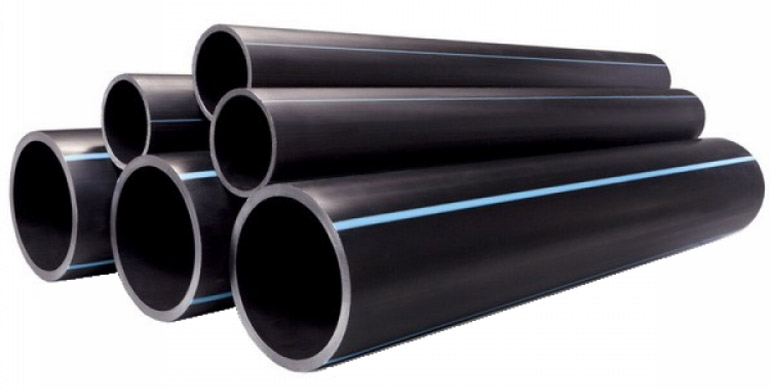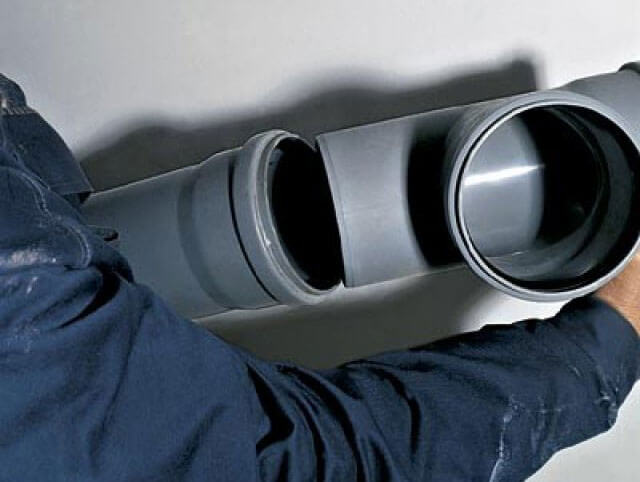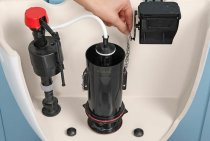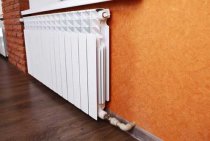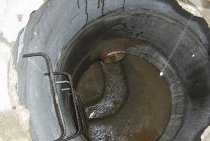Properties and characteristics of pipe pressure products
Pressure pipes are called low-pressure polyethylene pipes, the walls of which are able to withstand the supply of a working medium under pressure.
Such pipes have a set of properties, both characteristic of any plastic products, and available only for HDPE components:
- Environmental Safety. Polyethylene, like other polymers, does not decompose, does not react with most transported liquid and gaseous substances, and does not release toxins into the environment.
- Durability. If the operating conditions are observed, pressure polymer products can last more than 50 years.
- Flexibility and elasticity. Pressure pipe products are not afraid of bending, if necessary, they can be expanded at the ends and do not lose strength.
- Smooth inner and outer surfaces. Polymer pipes are not prone to silting and clogging, since the particles of the working medium have nothing to catch on if there are no damages on the walls. And in combination with elasticity, smooth outer walls make it possible to lay HDPE pipes inside old pipelines, making reconstruction without dismantling.
- Ease of installation. Plastic pipes are lightweight, easy to cut and have several connection options, which makes working with them possible without special skills.
- Strength. During the production process, polyethylene molecules form a strong crystalline structure that does not lose its strength properties under temperature, chemical, and mechanical effects.
- Sound absorption. Thick and soft plastic walls absorb the sound and vibration of the moving working environment.
- Instability to ultraviolet, extreme temperatures and intense mechanical stress. For laying without a casing in open spaces, under footpaths and roads, as well as at shallow depths in cold regions and in an open way near heat sources, pressure polyethylene pipes are not suitable.
- Fire danger. Products made of polyethylene are flammable and, when burned, emit substances hazardous to life and health.
Technical characteristics of pressure polyethylene pipes:
| Parameter | Units | Range |
| Polyethylene brand | from 32 to 100+ | |
| Diameter | mm | from 32 to 1600 |
| Wall thickness | mm | from 2 to 73.5 |
| SDR (ratio of the two previous characteristics) | from 6 to 41 | |
| Length | m | 12-1000 |
| Operating pressure | bar | from 3 to 25 |
| Working temperature | ºС | -60 to +80 |
| Optimum temperature | ºС | +40 |
| Life time | years | about 50 |
Laying of sewer pipelines from high-density polyethylene pipes with a diameter of 110 mm
LOCAL RESOURCE STATEMENT GESN 16-04-001-02
| Name | unit of measurement |
| Laying of sewerage pipelines from high density polyethylene pipes with a diameter: 110 mm | 100 m pipeline |
| Scope of work | |
| 01. Laying a pipeline from ready-made units with sealing of sockets with sealing rings. 02. Installation and termination of fasteners. 03. Installation of gate valves. 04. Pipeline testing. |
PRICE VALUES
The quotation does not include overhead costs and estimated profit, respectively, the direct costs of work for the period are indicated 2000 (prices of the Moscow region), which are calculated based on the standards 2009. For further calculations, this cost must be multiplied by the transition index to current prices.
You can go to the pricing page, which is calculated based on the 2014 revision standards with additions 1
GESN-2001 was used to determine the composition and consumption of materials, machines and labor costs
LABOR
| № | Name | Unit Change | Labor costs |
| 1 | Labor costs of construction workers Category 4.2 | man-hour | 61,6 |
| 2 | Labor costs of machinists (for reference, included in the cost of EM) | man-hour | 0,05 |
| Total labor costs of workers | man-hour | 61,6 | |
| Wages of workers = 61.6 x 9.91 | Rub. | 610,46 | |
| Machinist wages = 0.91 (for overhead and profit calculation) | Rub. | 0,91 |
OPERATION OF MACHINES AND MECHANISMS
| № | Cipher | Name | Unit Change | Consumption | St-st unit Rub. | TotalRUB. |
| 1 | 020129 | Tower cranes when working on other types of construction 8 t | mash.-h | 0,03 | 86,4 | 2,59 |
| 2 | 021141 | Truck-mounted cranes when working on other types of construction 10 t | mash.-h | 0,02 | 111,99 | 2,24 |
| 3 | 400001 | Cars onboard, carrying capacity up to 5 tons | mash.-h | 0,02 | 87,17 | 1,74 |
| Total | Rub. | 6,58 |
CONSUMPTION OF MATERIALS
| № | Cipher | Name | Unit Change | Consumption | St-st unit Rub. | TotalRUB. |
| 1 | 101-2449 | Rubber rings for cast iron pressure pipes with a diameter of 50-300 mm | kg | 4 | 24,41 | 97,64 |
| 2 | 101-2576 | Bolts with nuts and washers for sanitary works with a diameter of 16 mm | T | 0,00266 | 14830 | 39,45 |
| 3 | 301-9240 | Mounts | kg | 0,00 | ||
| 4 | 302-9120 | gate valves | PC. | 0,00 | ||
| 5 | 411-0001 | Water | m3 | 1,57 | 2,44 | 3,83 |
| 6 | 302-9661 | Sewerage pipelines made of high-density polyethylene pipes with sleeves, 100 mm in diameter | m | 99,8 | 0,00 | |
| Total | Rub. | 140,92 |
TOTAL RESOURCES: RUB 147.49
TOTAL PRICE: RUB 757.95
Look at the cost of this standard at current prices open the page
Compare the value of the price with the value of FER 16-04-001-02
To draw up an estimate, the price requires indexing the transition to current prices. The price is compiled according to the standards of GESN-2001 edition 2009 in prices 2000.To determine the intermediate and final values of the price, the DefSmeta program was used
Estimate for the construction of a house, for the repair and decoration of apartments - the program DefSmeta
Program rentalThe program provides an assistant who will turn the budgeting into a game.
Laying of sewer communications from polyethylene products
Due to such qualities of polyethylene pipes as high speed and ease of installation, such products are in high demand among plumbers.
Black polyethylene sewer pipe is good for creating an internal type of pipeline. At the same time, you do not need any special equipment for its installation. Docking of pipes, the cross section of which is within 110 mm, is carried out by means of compression fittings.
Pipelines made of polyethylene pipes for external sewerage are connected by butt welding. This process is several times faster than welding with metal products and does not require additional consumables or sophisticated equipment. Moreover, after work, an even, high-quality weld is obtained, which provides sufficient tightness for the full functioning of the system.
The presence of special installation equipment for polyethylene sewer pipes makes it possible to simplify the laying of the pipeline to the maximum, and the number of joints in this case can be minimized in comparison with similar pipelines made of rolled steel.
Sewer communications from polyethylene pipes can be laid in two ways: in a previously prepared trench in compliance with all standards for such work; inside an already existing sewerage system made of steel tubular products.
